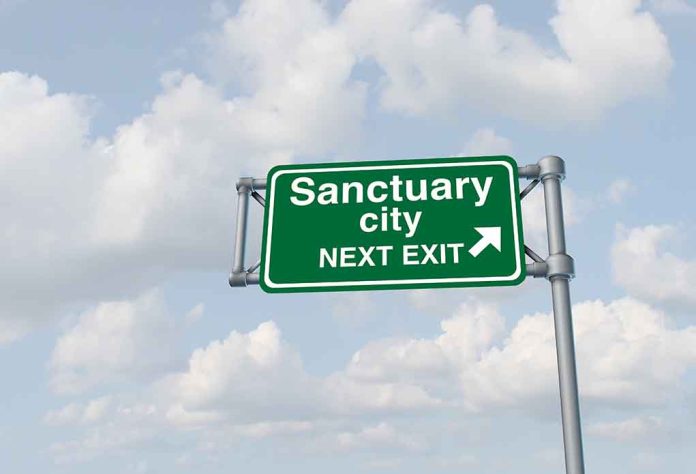🔴 Website 👉 https://u-s-news.com/
Telegram 👉 https://t.me/usnewscom_channel
President Trump’s sweeping law enforcement executive order hands police military equipment and legal protections while facing a judge’s immediate block on funding cuts to sanctuary cities.
Key Takeaways
- Trump’s executive order directs the Attorney General to provide legal resources for officers, improve training, increase pay, and strengthen legal protections against frivolous lawsuits.
- The order allows law enforcement agencies to receive surplus military assets and equipment to strengthen their capabilities in fighting crime.
- It targets “illegal race- and gender-based ‘equity’ policies” that have hampered effective policing and holds local officials accountable for obstructing criminal law enforcement.
- A federal judge has already blocked the administration from cutting funding to sanctuary cities, signaling ongoing legal battles over federal authority.
- The executive order is part of Trump’s broader “Make America Safe Again” initiative that includes border security and deportation of criminal illegal aliens.
Strengthening Police Resources and Protections
President Donald Trump has taken decisive action to bolster America’s law enforcement agencies through a comprehensive executive order that addresses the challenges faced by police officers nationwide. The order directs the Attorney General to provide critical legal resources for officers, particularly those facing litigation related to their duties. It also calls for improved training protocols, increased officer compensation, and enhanced legal protections that shield officers from baseless accusations and lawsuits that have become increasingly common in recent years.
The executive order specifically targets what it describes as “illegal race- and gender-based ‘equity’ policies” that have been implemented by previous administrations and local governments. These diversity, equity, and inclusion (DEI) initiatives have, according to the White House, hampered effective law enforcement and contributed to rising crime rates across the country. By redirecting resources away from these ideologically-driven programs and toward actual crime prevention, the administration aims to restore law and order to American communities that have suffered under progressive policies.
Military Equipment and Interagency Coordination
A significant aspect of the executive order involves providing law enforcement agencies with surplus military and national security assets. This provision will enable local police departments to access equipment that can enhance their capabilities in addressing serious crime and emergency situations. This approach represents a reversal of policies implemented during previous administrations that limited the transfer of military equipment to civilian law enforcement agencies, a restriction that many officers and departments have criticized as hampering their ability to respond effectively to violent crime.
The order also emphasizes improved coordination between federal and local law enforcement through Homeland Security Task Forces. These task forces will facilitate better information sharing, joint operations, and resource allocation to combat criminal organizations that operate across jurisdictional boundaries. This approach recognizes that many serious crime problems, particularly those related to drug trafficking and gang violence, require coordinated responses from multiple agencies at different levels of government rather than isolated local initiatives.
Targeting Sanctuary Jurisdictions
In a parallel executive action, President Trump has directed federal agencies to bring jurisdictions with sanctuary policies into compliance with federal immigration law. The administration has accused certain local officials of deliberately obstructing federal immigration enforcement, creating safe havens for criminal illegal aliens who should be deported. The Justice Department has already taken action against several jurisdictions, including filing lawsuits against the City of Rochester for its sanctuary policies and challenging New York’s Green Light Law, which restricts federal access to state driver’s license information.
However, this aspect of the administration’s law enforcement strategy has already encountered judicial resistance. A federal judge has blocked the implementation of funding cuts to cities with sanctuary policies, ruling that such actions violate constitutional principles regarding separation of powers and the Spending Clause. This ruling highlights the ongoing tension between federal authority and local control over immigration enforcement policies, a conflict that has intensified during President Trump’s tenure as he works to fulfill his campaign promise to secure America’s borders.
Reversing Failed Progressive Policies
The executive order explicitly criticizes Democrat-led policies for contributing to increased crime and social disorder across the country. These policies include bail reform measures that have released repeat offenders back onto the streets, restrictions on police tactics that limit officers’ ability to prevent and respond to crime, and DEI initiatives that prioritize ideological goals over public safety. The administration argues that these progressive approaches have undermined law enforcement effectiveness and endangered the communities they claim to serve.
President Trump’s executive order represents a significant shift away from the soft-on-crime approaches of recent years and toward a more robust support for law enforcement agencies. By providing officers with the resources, equipment, and legal protections they need to effectively perform their duties, the administration aims to fulfill its promise to “Make America Safe Again.” This comprehensive approach addresses both the practical needs of law enforcement agencies and the legal and policy barriers that have hindered their effectiveness, demonstrating the President’s commitment to restoring law and order nationwide.

